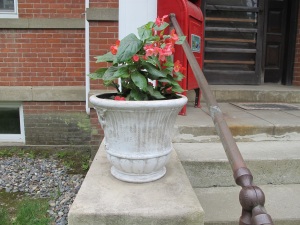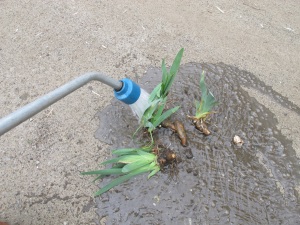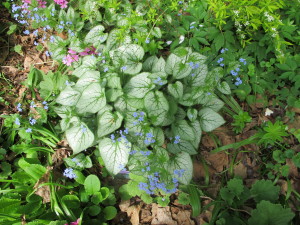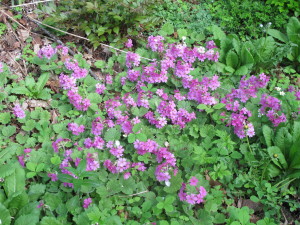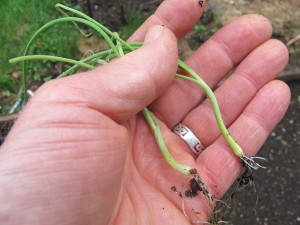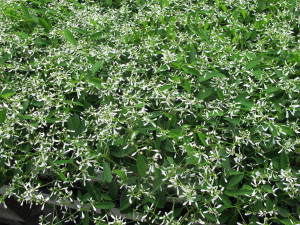Heroines of the Gardening World
I’d like to tip my hat the unsung heroines of the gardening world, the members of garden clubs around the region. Garden club members have recently been busy planting annual flowers at their local libraries, in the middle of roundabouts and in front of firehouses. And that is just the tip of the iceberg. The women (and occasionally men) of garden clubs are hardworking and generous. They provide their communities with much that we should all be grateful for.
If you are a new gardener, the best thing you can do is to join a garden club. The wealth of knowledge of the members is truly amazing. They know what grows in your town, and what does not. They know when the last frost will nip at the heels of your annuals and who in town has good compost for sale by the truckload. Not only that, garden club members love helping others, especially new gardeners.
The educational programs are a big draw for any club. Join the club (generally from $5 to $25 per year) and you get access to 6 or more speakers over the course of the year. Smaller clubs depend on local experts, but the bigger ones can afford to bring in outside experts and published authors. To me, the speaker programs are the core of the clubs. We all want to learn, and speakers can share information and often offer great slide shows.
This is the season when garden clubs are having their annual plant sales, another good money maker for the clubs – and less expensive plants for you, the gardener. One word of warning, however, some of these low-cost plants may harbor roots of invasive plants – and unknowingly introduce them to your garden.
Years ago I got goutweed (Aegopodium podagraria) mixed in with iris given to me and have never been able to rid myself of the pest. Once established, goutweed is practically impossible to get rid of – I generally recommend selling the house. Now when getting plants from plant sales I “bare root” them before planting. That means I wash all soil off the roots, removing anything that is not clearly a root from the desired plant. I do this in the driveway so that any invasive plant roots don’t get into my soil.
One of my favorite garden clubs is in Lyme, NH. It’s an informal club called the Lyme Gardeners – no dues, no officers, no pledge of allegiance at meetings. I contacted Anne Baird, who once invited me to speak to their group and made me a lifetime member. In an e-mail she described the club as follows:
“We visit around 16 Upper Valley gardens from May through September, with a focus on working, not show gardens. ‘Pardon My Garden’ allows host gardeners to ask for help with problems, talk about down- or up-sizing, and for visitors to share experience, knowledge, and enthusiasm.
“During the off-seasons, Lyme Gardeners has occasional potluck suppers, with special guests talking about anything from herbal medicines to winter gardens to favorite tools. Anyone in the Upper Valley with a passion for gardening, whether experienced, brand-new, or no longer active, is welcome at any Lyme Gardener event. Join Lyme Gardener’s listserv: lyme-gardeners@lists.valley.net.”
Many garden clubs offer garden tours of members’ gardens. Gardeners often spend weeks getting ready, pulling every weed, edging every bed. Some hire outside help to get their gardens ready. The “Pardon My Garden” events are different. Weeds are to be expected. Gardeners share what they are doing, but visitors do not expect Martha Stewart-like displays. I like that.
Garden clubs often offer scholarship monies to students in their towns. As a regular speaker at garden clubs I often must sit through the official meetings, including the treasurer’s reports. Some of these clubs raise substantial sums of money, and then share it with needy students, particularly to those with an interest in horticulture. Very nice.
My local garden club’s big fundraiser is a raffle at the Cornish Fair, held every year the third weekend of August. The club gets local merchants to donate to the raffle items and tickets are sold for a dollar a pop. To get you there, the Garden Club has a competition open to all for best flower arrangement, best potted plants, best miniature display, etc. My favorite category is “Best Smelling Flower As Judged By a Child”.
So join a club – or start an informal group like the Lyme Gardeners – so that you can learn from other gardeners. We can all learn from the victories and mistakes of others.
Henry can be reached by e-mail at henry.homeyer@comcast.net. His web site is www.Gardening-Guy.com.
Pondering a Few Perennial Flowers
I aspire to be the Goatsbeard King of Cornish Flat. Maybe I already am. I have several, and no one else I know here grows goatsbeard (Aruncus dioecious). It is one of many flowers I grow that do well in light shade, getting bigger and better every year, and requiring very little of me.
Long ago, decades ago, I bought my first goatsbeard. The plant tag said it would grow in shade, so I foolishly planted it under a Canadian hemlock. It survived, but never bloomed. In terms of sunshine, planting it there was akin to planting it in under a box– virtually no light; additionally, there was lots of root competition from the tree. Then after 10 years I moved it to a place that got nice morning sun, but no afternoon sun. It bloomed and thrived, which taught me to move plants that aren’t thriving.
Goatsbeard blooms in early summer with tall plumes of fluffy white flowers (similar to astilbe flowers) rising above its tall foliage. There are male plants and female plants, though honestly I do not know which is which. (It’s not like puppies, where you just lift up the tail and look). Books tell me the males are showier. The leaves on mine are 3 to 4 feet tall and the clumps get bigger every year. I also have a miniature goatsbeard (A. aethusifolius) that is very nice and compact, and stays just 8 to 15 inches tall and has small white spikes of delicate white flowers that, like its big brother, stand above the foliage.
There are many kinds of shade. Most perennials that grow in shade need some sunshine filtered through canopy of leaves, not an umbrella of shade from evergreens. Morning sun that washes a plant for a few hours early in the day is fine for a shade plant but hot afternoon sun generally is too much. And if a plant is rated for use in the shade, moist soil will usually help it thrive if it gets more direct sun than it would like (otherwise it would dry it out in the sun).
One of my favorite flowers is blooming everywhere right now for me. Forget-me-nots (Myosotis sylvatica) have small 5-petaled light blue flowers on 8- to 15- inch stems, though I have a few with white or pink flowers. They spread by seed, creating waves of color in shade or part shade locations, or even in sunny places. These plants are never a problem: if one pops up somewhere that is designated for another plant, it is easy to remove as its roots are not at all tenacious. It is not clear from the literature if forget-me-nots are annuals, biennials or perennials. If perennials, they are short-lived ones.
A perennial with flowers nearly identical to forget-me-nots is Siberian bugloss, more commonly called Brunnera, which is its Latin name (Brunnera macrophylla). A named cultivar, “Jack Frost’, is one of the most common. The leaves are smaller than the standard species leaves, and are “frosted” with white. The leaves are heart-shaped and very handsome all summer. Any plant with variegated leaves – those that have a lack of green chlorophyll in parts – tend to be smaller and less vigorous, as the white portions do not produce food for the plant.
Primroses are in bloom for me now and are some of my favorites. One with no common name is Primula kisoana, a brilliant magenta flower that spreads nicely by root, but never overpowers other plants. It likes shade and will grow in dry or moist soil. I even have it growing on a rock ledge that only has an inch of soil and it is happy there, too.
Another great primrose is the Japanese primrose (Primula japonica). This is also called the candelabra primrose because it displays 3 or more tiers of umbels (umbrella-shaped clusters of flowers) separated by a few inches of stem. These need moist or even wet soil and do well for me under apple trees in rich, black soil. Most primroses seem to like growing under apples. This one blooms just after P. kisoana, providing continuous color for 4 to 6 weeks between them.
Since early April – and continuing into June – I have had hellebores blooming in dry shade. Also called Lenten rose (Helleborus orientalis), these have handsome evergreen leaves and 2- to 3-inch diameter five-petaled flowers. The flowers are good looking even when past their prime (like many gardeners I know). I have them growing in dry soil in a shady location that gets a little morning sun. If you haven’t tried them, you should. Their colors range from white to deep maroon, and hybrids now come in doubles (with extra petals). ‘Peppermint Ice’ is a very nice double hybrid.
In that same bed with the hellebores I have some very nice anemones, one called Anemone nemorosa. Not all anemones are nice, however. There is a common one often found at plant sales called Canadian or meadow anemone (Anemone canadensis). It has a pretty white flower, but spreads too quickly and cannot be easily removed or controlled. A thug. But A. nemorosa stays in nice clumps with 1-inch lavender or white blossoms on 6 inch stems. Fall blooming Japanese anemones (A. x hybrida) are wonderful, too.
An easy shade-blooming ground cover is spotted deadnettle (Lamium maculatum). It has small pink-mauve flowers on square stems, but the flowers are not showy. It will spread quickly. Its foliage is 6- to 8-inches tall and each leaf has a white stripe up the middle.
Shade is too often neglected by gardeners. There are so many flowers that will thrive there, you really must try some new ones this year. Head for your local family-owned nursery and see what grabs your fancy. And who knows? Maybe you’ll come home with goats (beard)!
Henry Homeyer is a gardening consultant and author. His web site is www.Gardening-Guy.com.
Early Summer in the Garden
Every spring each of us must decide when to plant our tender annual plants. I am of the conservative branch of the gardening family. I do not want to take a chance damaging – or killing – my tomatoes, peppers, cukes, or annual flowers if a late frost comes along. I know gardeners who are planting everything now – and they might be smarter than me. But I doubt they will get tomatoes before me. Plants going into cold soil don’t really do much growing.
Whether you buy your plants from a nursery or start them yourself from seed, all plants need to be hardened off before being planted. That means introducing them to sunshine and breezes a little at a time so that they don’t get sun or wind burned. Ask at the garden center if their plants have been well hardened off when you buy them.
I have a deck on the north side of my house that gets about 3 hours of morning sun each day, so it is the perfect place to start hardening off seedlings. After 3 days on the deck, I move the trays of seedlings to the west side, where they get afternoon sun but are a bit sheltered from drying winds. After three days there, they are ready to be planted, weather permitting.
I like to plant in the early evening. Robins are singing complex melodies, and the sun’s heat has diminished. Most importantly, plants have 12 hours or so to settle into the soil, absorb some water, and get ready to grow before the sun comes up and bakes them. I also like to plant when cloudy or drizzly weather is forecast, but that isn’t always possible.
Here are some of the things I am planting now, or have planted. Peas went in first, after 2 hours soaking in a dish of water. This allows the seeds to absorb water quickly, encouraging them to start growing sooner than if I just put them in the ground. I planted Sugar Snap peas, which are edible pod peas. I find shelling peas tedious, and like the fact that you get more food if you can eat the shells.
Peas (and beans) are legumes which means that they can take nitrogen from the air and “fix” it into a form useable by plants – but only with the help of nitrogen fixing bacteria. Your soil may have these rhizobial bacteria, or it might not. Without them, the plants cannot fix nitrogen. So you may want to buy a packet of the bacteria, which comes in a powder form. After soaking the peas, drain the water and sprinkle inoculant over the seeds before planting.
Generally the packet of inoculant contains more than you need; it will not be good next year, so share your extra with a friend. I suppose you can mix in water and spread it on the soil around your peas if you have already planted your peas without it. Beans, by the way, are warm weather plants that should not be planted until after risk of frost. If you plant them in cold, wet soil they may rot, too.
Carrots, beets, radishes and rutabagas are good crops to plant now. I planted mine on Mother’s Day, as it was a root day, according to Stella Natura, the biodynamic calendar I consult when planting (www.stellanatura.com). It uses the moon and stars to guide when we should plant.
Beets confused me until I learned that the “seeds” we buy are not seeds at all, but dried seed capsules. Like an apple, each capsule contains multiple seeds. So you can space them perfectly, and still have to thin them later. Johnny’s Selected Seeds (www.johnnyseeds.com) does sell one variety called ‘Moneta’ that only has one seed per capsule – but it often sells out early.
Thinning plants that I start from seed is one of my least favorite activities. It takes time and precision, and it is killing little plant babies! So when planting things like carrots or rutabagas I try to take time to space seeds an inch apart, though I haven’t yet perfected that trick. Patience is not my long suit. By the 4th of July, carrots and beets should be at least an inch apart, and eventually, 2 to 3 inches apart. If crowded, carrots will compete with other carrots just the way weeds compete with carrots.
I have also planted onions, which I do as small plants, not sets. My grandfather always planted sets, which are really just stunted onions that grew last year. Growers plant them so close together that they are dwarfed – and you should plant them like big seeds.
This year I planted my onions by seed indoors in early March, and raised them under lights for 2 months before hardening them off and putting them in the garden. I planted them and inch and a half deep, and 2 to 3 inches apart. Some seed companies will sell onion plants in bundles of 50 for those wanting seedlings – I have gotten them from Johnny’s Selected Seeds in the past. Starting from seed is nice because you have more choice about the variety you plant.
I hope to plant kale, broccoli and Brussels sprouts this week – all are quite frost hardy. If I plant cauliflower, I will wait to plant it in June. Cauliflower is the fussbudget of the brassica (cabbage) family. It will “button” or fail to produce a full-sized head if it is stressed by weather that is too hot or too cold, too wet or too dry. The others? Rock solid. In the fall most of the brassicas will continue producing until Thanksgiving or later.
This is a joyous season for me. Planting seeds is magical. Imagine planting a speck, and getting a carrot later this summer. I love it!
Henry Homeyer can be reached at PO Box 364, Cornish Flat, NH 03746. Please include a self-addressed, stamped envelope if you wish a response to a question. Or e-mail Henry at henry.homeyer@comcast.net.
Annual Flowers: A Great Gift for Mom!
Okay, Mom’s Day is coming right up, and you haven’t bought her anything. Instead of getting another electric waffle iron or promising to wash her car, just like you did last year (but haven’t done yet), head to your local family-owned garden center. There are plenty of these, and they are ready and waiting for you. The flowers you get there will be perfect for this climate, and tried and tested by the owners and staff.
Here is what I am suggesting: make a nice planter full of annual flowers that will bloom all summer. Mom will think of you every time she waters it. But before you buy things, think about the sun conditions where she will place it. If it will go on a north-facing deck, you need flowers whose tags include the words “shade” or “part shade.” A few annuals are even labeled “sun to shade,” but they are rare. If the plant is going in full sun, or all afternoon sun, look for tags that say “sun.”
If you are buying a pot to place your gift in, consider these factors: old fashioned clay pots are nice, but they lose water through the pores, allowing the roots to dry out faster than a nice glazed ceramic pot would, or (for those on a strict budget) a plastic or fiberglass pot. If Mom is busy, and I’ve never met one who isn’t, you should probably avoid the clay pots.
When it comes to pots, bigger is better. More room for soil and for plants that want to expand. More potting mix to hold moisture. Don’t think the flowering plant you buy will stay that size. It will grow. Six cubic inches of potting soil per plant is the rule of thumb, though often I don’t follow that – and squeeze in more plants.
Self-watering planters are good, too. These pots have a water reservoir in the base, below a shelf, and a wicking system that keeps roots moist, but not soggy. Fill that reservoir once a week and the soil stays adequately moist in most situations. They cost more, but hey, Mom was good to you. (Remember all those rhubarb pies she made when you were growing up?).
What should you put in the pot? Certainly not ordinary dirt (or soil as we are supposed to say). I use a 50-50 mix of potting soil and compost, my own or purchased. Moo-Doo brand composted cow manure works great, but there are plenty of kinds. If you have a 16-inch diameter pot (a nice size) you can also mix into the soil ingredients a half-cup of slow release organic fertilizer, or less for smaller pots.
The basic design principal for planters is this: if you have a big planter (16- to 24-inches across) put something tall in the middle, surrounded by 3-complimenatry-colored medium sized plants, and then squeeze in some “trailers” that will hang over the edges. The trailers may be just foliage plants, or blooming plants. A 10- to 12-inch planter can have a tall or medium height plant, and some trailers. Or you can buy three or more 6- to 8-inch pots and put just one plant in each, and then arrange the pots in a nice trio.
Now the plants. There are plenty of nice ones, from old fashioned petunias (Mom, may she rest in peace, usually got these from me on Mother’s Day when I was a boy), to new things that are trademarked hybrids. Almost all will bloom all summer, though some like Osteospurmum look great in spring and fall, but are just foliage in the heat of summer. I visited my favorite garden center recently, and got lots of the ideas for planters.
Let’s start with the shade. Impatiens was the favorite for decades, then a few years ago, along came a blight that ruined them. In pots on a deck, with fresh soil, you will probably do just fine. They are a medium-sized plant that never stops blooming till frost, and come in a variety of colors, and with both single and double blossoms. I am still leery of planting them in the ground, especially if the blight ever struck there in the past.
Other shade plants? Torenia is being promoted to replace Impatiens. It is nice, but not as dramatic (for me, anyhow). New Guinea Impatiens is also good, but is rarely sold in those inexpensive 6-packs. Begonias can be great; I saw a black-leafed one with white blossoms that I liked called ‘Mocca White”. Oxalis is a favorite of mine and I bring it inside each fall and winter it over as a houseplant.
For sun there are even more plants to choose from. I like Superbenas, which are trademarked, hybridized verbenas, and Supertunias (the same, but derived from petunias). ‘Diamond Frost’ is a Euphorbia hybrid that has huge numbers of tiny white blossoms all summer. Angelonia has a 20-inch stalk with lots of pink blossoms. Salvias are great plants, with plenty of sizes, heights and colors. Licorice plant (Helichrysum) is a great foliage plants that takes hot, sunny locations. It comes in gray and chartreuse-leafed varieties. Persian shield has shiny purple leaves for hot, dry places.
Don’t take my advice when it comes to plants: ask those friendly folks at your garden center. They deal with them all day, every day, and probably take injured plants home, free. So get Mom something nice, she’ll love you for it – even if the colors clash.
Henry is the author of 4 gardening books (also good Mothers Day presents). His web site is www.Gardening-Guy.com.



